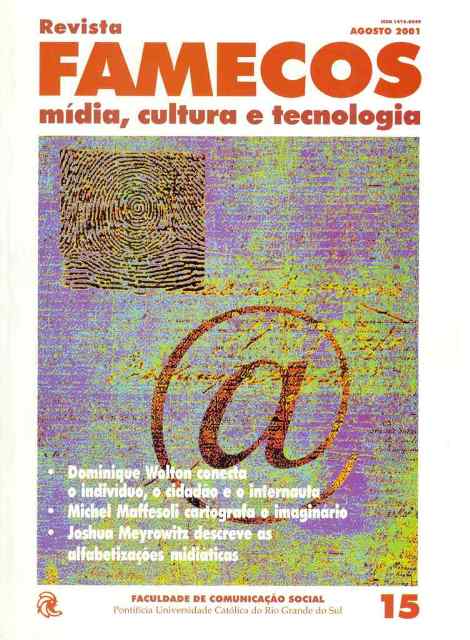As múltiplas alfabetizações midiáticas
DOI:
https://doi.org/10.15448/1980-3729.2001.15.3125Palabras clave:
Tecnologia, gramática midiática, linguagemResumen
Existem pelo menos três tipos de alfabetizações midiáticas, cada uma delas ligada a uma diferente concepção do que nós pretendemos dizer com o termo mídia. A noção de que os mídia são condutores que transmitem mensagens aponta para a necessidade da alfabetização no conteúdo dos mídia. A idéia de que os mídia são diferentes linguagens sugere a necessidade de alfabetização numa gramática midiática, isto é, entender o significado das variáveis de produção dentro de cada meio. A concepção dos mídia como ambientes sugere a necessidade de se perceber a influência das características relativamente fixas de cada meio (alfabetização midiática), tanto nas comunicações individuais como nos processos sociais em geral. A alfabetização mediática, em particular, oferece algumas idéias especiais no que se refere as origens, problemas, e possibilidades de um movimento pela alfabetização midiática.Descargas
Citas
ALTHEIDE, D.L. Creating reality: How TV news disorts events. Beverly Hills, CA: Sage, 1976.
BARNOUW, E. The sponsor: Notes on a modern pontentate. New York: Oxford University Press, 1978.
GANS, H.J. Deciding what´s news. New York: Vintage, 1979.
HALLIN, D. We keep America on top of the world: Television journalism and the public sphere. New York: Routledge, 1994.
HERMAN, E. S. e CHOMSKY, N. Manufacturing consent : The political economy of the mass media. New York: Pantheon, 1988.
McLUHAN, M. Understanding media: The extensions of man. New York: Signet, 1964.
MANOFF, R.K. e SCHUDSON, M. (eds.) Reading the news. New York: Pantheon Books, 1986.MEYROWITZ, J. No sense of place: The impact of eletronic media on social behavior. New York: Oxford University Press, 1985.
______. Television and interpersonal behavior: Codes of percepcion and response. In G. Gumpert & R. R. Cathcart (Eds.), Inter/Media: Interpersonal communication in a media world (3rd. Ed., pp.253-272). New York: Oxford University Press, 1986.
______. Medium theory. In D. Crowley & D. Mitchell (Eds.)
Communication theory today (pp. 50-77). Cambridge, England: Polity Press, 1994.
PAPERT, S. The Children´s machine: Rethinking school in the age of the computer. New York: Basic Books, 1993.
SAVAN, L. The Sponsored life: Ads, TV, an Amarican culture. Philadelphia:Temple University Press, 1994.
SCHRAMM, W. Men, messages, and media: A look at human communication. New York: Harper & Row, 1973.
SCHUDSON, M. The power of news. Cambridge, MA: Harvard University Press, 1995.
SIGAL, L. Reporters and offi cials. Lexington, MA: Heath, 1973.
WEBSTER, K. e MEYROWITZ, J. Whose views make news? Cable in the classroom, p. 10-11, July/August, 1995.
ZETTL, H. Sight-sound-motion: Applied media aesthetics (2a ed.). Belmont, CA: Wadsworth, 1990.
Descargas
Publicado
Cómo citar
Número
Sección
Licencia
Derechos de Autor
La sumisión de originales para la Revista Famecos implica la transferencia, por los autores, de los derechos de publicación. El copyright de los artículos de esta revista es el autor, junto con los derechos de la revista a la primera publicación. Los autores sólo podrán utilizar los mismos resultados en otras publicaciones indicando claramente a Revista Famecos como el medio de la publicación original.
Creative Commons License
Excepto donde especificado de modo diferente, se aplican a la materia publicada en este periódico los términos de una licencia Creative Commons Atribución 4.0 Internacional, que permite el uso irrestricto, la distribución y la reproducción en cualquier medio siempre y cuando la publicación original sea correctamente citada.






